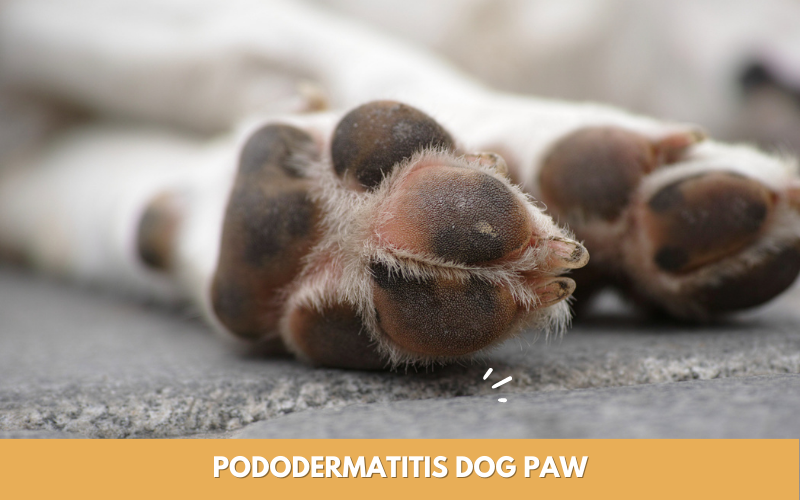Pododermatitis dog paw is a painful condition that affects a dog’s paw pads, causing inflammation and discomfort. If left untreated, it can progress and lead to serious health complications. As pet owners, it’s our responsibility to ensure that our furry friends are healthy and happy. That’s why it’s important to be aware of the signs and symptoms of pododermatitis dog paw, so we can seek treatment and alleviate our dog’s discomfort as soon as possible. In this article, we’ll talk about what pododermatitis is, its causes, symptoms, and treatments, so you can be informed and prepared to take action if your furry friend is affected.
What is pododermatitis dog paw?
Pododermatitis dog paw is a condition that causes inflammation and pain in the pads of a dog’s feet. It is also known as “interdigital dermatitis” or “footpad dermatitis“. The condition can affect one or more paws and is typically characterized by redness, swelling, and sometimes ulceration of the paw pads.
Is pododermatitis contagious?
Pododermatitis is not contagious in and of itself, as it is not caused by a virus or bacteria that can be spread from dog to dog. However, some of the underlying causes of pododermatitis, such as bacterial or fungal infection dog pododermatitis dog paw, can be contagious. It’s important to take steps to prevent the spread of these underlying infections to other dogs, as well as to humans.
Is pododermatitis painful?
Yes, pododermatitis can be painful for dogs. The inflammation and ulceration of the paw pads can cause discomfort and pain, particularly when the affected area is touched or pressure is applied to the paw. Dogs with pododermatitis may limp or favor the affected paw(s) and may be reluctant to walk or play.
Is pododermatitis deadly?
Pododermatitis itself is not typically a deadly condition. However, if left untreated, it can lead to serious complications such as secondary infections or lameness, which can affect a dog’s quality of life. In rare cases, pododermatitis may be a symptom of an underlying condition that could potentially be life-threatening, such as an autoimmune disorder. It’s important to seek veterinary care promptly if you suspect your dog may have pododermatitis.
Pictures of pododermatitis in dogs
Here are some pictures of pododermatitis dog paw that can help you identify this painful condition affecting their paws.

Pododermatitis dog paw causes
Pododermatitis dog paw can have several causes, including:
Infections
Bacterial, fungal, and parasitic infections can cause pododermatitis in dogs. These infections can be acquired from contaminated soil, water, or other environmental factors.
Allergies
Dogs can develop pododermatitis as a result of an allergic reaction to a substance they come into contact with, such as grass, pollen, or certain foods. This is known as allergic pododermatitis.
Foreign bodies
Small objects like thorns, glass, or splinters can get lodged in a dog’s paw, leading to pododermatitis.
Genetics
Certain breeds are predisposed to developing pododermatitis, such as Shar Peis, Bulldogs, and Boxers. This may be due to an inherited structural or immune system abnormality.
Hormonal disorders
Hormonal imbalances, such as hypothyroidism or Cushing’s disease, can affect a dog’s immune system and increase their susceptibility to developing pododermatitis.
Immune-Mediated diseases
Pododermatitis can be a symptom of autoimmune disorders, such as lupus or pemphigus, which cause the immune system to attack healthy cells in the body.
Cancerous tumors
Rarely, pododermatitis can be caused by cancerous tumors, such as squamous cell carcinoma or melanoma, which can develop in the paw pads.
Finding out what causes pododermatitis dog paw is important for getting the right treatment and preventing the condition from coming back. If you think your dog might have pododermatitis, you should see a vet as soon as possible to find out what’s going on and start the right treatment.
Pododermatitis in dogs symptoms
Pododermatitis in dogs can cause a variety of symptoms, including:
- Redness and swelling of the paw pads
- Limping or lameness, particularly when walking or running
- Pain or discomfort when the affected area is touched or pressure is applied
- Ulceration or cracking of the paw pads
- Itching or licking of the affected paw(s)
- Unpleasant odor coming from the affected paw(s)
- Change in skin texture on the paw pads, such as thickening or scaling
- Discharge or oozing from the affected area.
The symptoms of pododermatitis dog paw can vary depending on the underlying cause of the condition. For example, if the condition is caused by a bacterial infection, there may be pus or other discharge present, whereas if the condition is caused by allergies, there may be more itching and inflammation.
How to diagnose pododermatitis dog paw?

Diagnosing pododermatitis dog paw typically involves a combination of physical examination, medical history, and diagnostic testing. Here are some of the steps a veterinarian may take to diagnose pododermatitis in dogs
Physical examination
The veterinarian will examine your dog’s paws, looking for signs of redness, swelling, ulceration, or discharge. They may also examine the rest of your dog’s body to check for any other symptoms that could be related to the condition.
Medical history
The veterinarian will ask about your dog’s medical history, including any previous injuries, illnesses, or treatments. They may also ask about your dog’s diet and lifestyle to help determine if any underlying factors could be contributing to the condition.
Diagnostic testing
The veterinarian may perform a variety of diagnostic tests to help determine the underlying cause of the pododermatitis, such as skin scrapings, cultures, or biopsies. Blood tests may also be performed to check for hormonal imbalances or other underlying medical conditions.
X-rays
In some cases, X-rays may be taken to rule out the possibility of foreign objects or bone fractures that could be contributing to the condition.
Once a diagnosis has been made, the veterinarian can develop an appropriate treatment plan for your dog. You should follow your veterinarian’s instructions carefully and attend follow-up appointments as recommended to ensure the best possible outcome for your dog.
How is pododermatitis dog paw treated?
The treatment of pododermatitis dog paw depends on the underlying cause of the condition, as well as the severity and duration of the symptoms. Here are some common treatment options for pododermatitis dog paw:
- Pododermatitis dog medication: Antibiotics, antifungal agents, corticosteroids, and other medications may be prescribed to address the underlying cause of the pododermatitis and manage symptoms such as pain and inflammation.
- Topical treatments: Topical treatments such as medicated creams, ointments, or sprays may be prescribed to help reduce inflammation and promote healing of the affected paw pads.
- Dietary changes: If the pododermatitis is caused by an allergy or sensitivity to certain foods, changing your dog’s diet may be recommended. Your veterinarian may recommend a special hypoallergenic or limited-ingredient diet to help identify and eliminate the problem ingredient.
- Lifestyle changes: Making certain lifestyle changes can also help manage pododermatitis in dogs.
- Surgery: In rare cases, surgery may be necessary to address underlying issues such as tumors or foreign bodies that are contributing to the pododermatitis.
It’s needed to work closely with your veterinarian to develop an appropriate treatment plan for your dog, and to attend follow-up appointments as recommended to monitor your dog’s progress and make any necessary adjustments to their care.
Pododermatitis dog paw home remedy
While home remedies for pododermatitis dog paw may offer some temporary relief for your dog, it’s important to note that they are not a substitute for proper veterinary care and may not address the underlying cause of the condition. Here are some home remedies that may help manage symptoms of pododermatitis dog paw:
- Soaking: Soaking your dog’s paws in a mixture of warm water and Epsom salts may help reduce inflammation and promote healing. Be sure to dry your dog’s paws thoroughly after soaking.
- Herbal remedies: Some herbs, such as aloe vera and chamomile, may have anti-inflammatory properties that can help soothe your dog’s paw pads. Consult with a veterinarian before using any herbal remedies to ensure their safety and effectiveness.
- Protective booties: Protecting your dog’s paws with booties or socks can help prevent further irritation or injury to the affected paw pads.
- Omega-3 fatty acids: Adding omega-3 fatty acid supplements to your dog’s diet may help reduce inflammation and promote healing of the paw pads.
It’s necessary to consult with a veterinarian before trying any home remedies for pododermatitis dog paw, as some treatments may be ineffective or even harmful. In addition, if the underlying cause of the condition is not addressed, the pododermatitis is likely to recur. Seeking proper veterinary care and following your veterinarian’s treatment plan is the best way to ensure a successful outcome for your dog.
Prognosis for pododermatitis dog paw
There are many dog parents worry about whether can pododermatitis be cured? The prognosis for pododermatitis in dogs can vary depending on the underlying cause of the condition, as well as the severity and duration of the symptoms. In many cases, with appropriate treatment and management, dogs with pododermatitis can recover and resume a normal quality of life.
If pododermatitis is caused by a bacterial or fungal infection, for example, the prognosis is generally good with appropriate antimicrobial treatment. If the condition is caused by allergies or hormonal imbalances, however, the prognosis may depend on the ability to identify and manage the underlying cause. In some cases, such as with autoimmune disorders or cancerous tumors, the prognosis may be guarded or poor.
Some dogs may experience chronic or recurring symptoms despite treatment. In these cases, ongoing management and close monitoring may be necessary to prevent recurrence and maintain your dog’s comfort and quality of life.
How do I prevent pododermatitis from my dog?
There are several steps you can take to help prevent pododermatitis in your dog:
- Keep your dog’s paws clean and dry: Regularly clean your dog’s paws with a mild soap and warm water, and dry them thoroughly after your dog has been outside in wet or muddy conditions.
- Provide proper grooming: Keep your dog’s nails trimmed and hair between the paw pads trimmed to prevent irritation and the accumulation of debris.
- Avoid irritants: Limit your dog’s exposure to irritants such as chemicals, pesticides, and allergens.
- Provide a healthy diet: Feed your dog a healthy and balanced diet that is rich in nutrients, vitamins, and antioxidants to support overall health and immune function.
- Regular exercise: Regular exercise can help improve circulation and keep your dog’s paws healthy and strong.
- Check your dog’s paws regularly: Regularly inspect your dog’s paws for any signs of injury or irritation, and seek veterinary care promptly if you notice any changes.
- Use protective boots or socks: Consider using protective boots or socks to prevent injury or irritation to your dog’s paws during outdoor activities.
By taking these steps, you can help prevent pododermatitis in your dog and promote their overall health and well-being.
FAQs
Can I use human medications to treat my dog’s pododermatitis?
It is not recommended to use human medications to treat pododermatitis in dogs as they may not be safe or effective for use in animals. It’s important to consult with a veterinarian to determine the appropriate treatment for your dog.
How long does it take for pododermatitis in dogs to heal?
The healing time for pododermatitis in dogs depends on the underlying cause of the condition, as well as the severity and duration of the symptoms. In many cases, with appropriate treatment and management, dogs with pododermatitis can recover within a few weeks to a few months.
Can pododermatitis dog paw cause lameness?
Yes, pododermatitis in dogs can cause lameness if the condition is severe enough to cause pain or discomfort. Lameness can also occur if the pododermatitis is accompanied by other symptoms such as swelling or redness.
Can pododermatitis in dogs lead to amputation?
In rare cases, pododermatitis in dogs can lead to amputation if the condition is severe and other treatment options have been unsuccessful. However, with appropriate and timely intervention, most cases of pododermatitis can be successfully managed without the need for amputation.
Conclusion
In short, pododermatitis dog paw can be a painful and uncomfortable condition for our furry friends. It can have various underlying causes, including infections, allergies, and hormonal disorders. However, with timely intervention and appropriate treatment, many dogs can recover from pododermatitis and resume a normal quality of life. By working closely with your veterinarian and providing the necessary care and support, you can help your dog recover from pododermatitis and stay happy and healthy for years to come.

